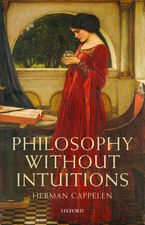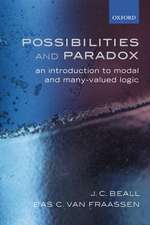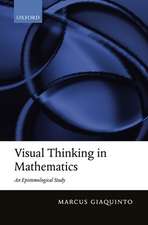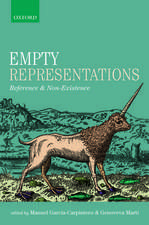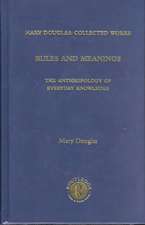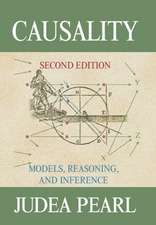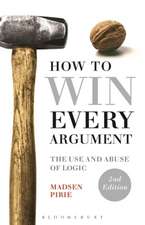Logic: The Basics: The Basics
Autor Jc Beall, Shay Allen Loganen Limba Engleză Hardback – 21 feb 2017
· mathematical preliminaries
· propositional logic
· quantified logic (first monadic, then polyadic)
· English and standard ‘symbolic translations’
· tableau procedures.
Alongside comprehensive coverage of the standard topics, this thoroughly revised second edition also introduces several philosophically important nonclassical logics, free logics, and modal logics, and gives the reader an idea of how they can take their knowledge further. With its wealth of exercises (solutions available in the encyclopedic online supplement), Logic: The Basics is a useful textbook for courses ranging from the introductory level to the early graduate level, and also as a reference for students and researchers in philosophical logic.
| Toate formatele și edițiile | Preț | Express |
|---|---|---|
| Paperback (1) | 154.93 lei 3-5 săpt. | +13.10 lei 6-12 zile |
| Taylor & Francis – 21 feb 2017 | 154.93 lei 3-5 săpt. | +13.10 lei 6-12 zile |
| Hardback (1) | 530.27 lei 6-8 săpt. | |
| Taylor & Francis – 21 feb 2017 | 530.27 lei 6-8 săpt. |
Din seria The Basics
-
 Preț: 154.16 lei
Preț: 154.16 lei -
 Preț: 153.91 lei
Preț: 153.91 lei -
 Preț: 153.64 lei
Preț: 153.64 lei -
 Preț: 153.76 lei
Preț: 153.76 lei -
 Preț: 153.79 lei
Preț: 153.79 lei -
 Preț: 146.22 lei
Preț: 146.22 lei -
 Preț: 153.72 lei
Preț: 153.72 lei -
 Preț: 154.26 lei
Preț: 154.26 lei -
 Preț: 154.93 lei
Preț: 154.93 lei -
 Preț: 153.88 lei
Preț: 153.88 lei -
 Preț: 154.05 lei
Preț: 154.05 lei -
 Preț: 154.51 lei
Preț: 154.51 lei -
 Preț: 154.23 lei
Preț: 154.23 lei -
 Preț: 153.37 lei
Preț: 153.37 lei -
 Preț: 154.96 lei
Preț: 154.96 lei -
 Preț: 153.91 lei
Preț: 153.91 lei -
 Preț: 154.96 lei
Preț: 154.96 lei -
 Preț: 154.68 lei
Preț: 154.68 lei -
 Preț: 156.08 lei
Preț: 156.08 lei -
 Preț: 153.64 lei
Preț: 153.64 lei -
 Preț: 145.80 lei
Preț: 145.80 lei -
 Preț: 154.29 lei
Preț: 154.29 lei -
 Preț: 153.78 lei
Preț: 153.78 lei -
 Preț: 156.31 lei
Preț: 156.31 lei -
 Preț: 148.72 lei
Preț: 148.72 lei -
 Preț: 115.89 lei
Preț: 115.89 lei -
 Preț: 137.16 lei
Preț: 137.16 lei -
 Preț: 153.64 lei
Preț: 153.64 lei -
 Preț: 154.05 lei
Preț: 154.05 lei -
 Preț: 146.32 lei
Preț: 146.32 lei -
 Preț: 136.06 lei
Preț: 136.06 lei -
 Preț: 153.94 lei
Preț: 153.94 lei -
 Preț: 154.90 lei
Preț: 154.90 lei -
 Preț: 153.38 lei
Preț: 153.38 lei -
 Preț: 155.40 lei
Preț: 155.40 lei -
 Preț: 153.85 lei
Preț: 153.85 lei -
 Preț: 153.64 lei
Preț: 153.64 lei -
 Preț: 153.54 lei
Preț: 153.54 lei -
 Preț: 152.69 lei
Preț: 152.69 lei -
 Preț: 153.79 lei
Preț: 153.79 lei -
 Preț: 154.05 lei
Preț: 154.05 lei -
 Preț: 154.41 lei
Preț: 154.41 lei -
 Preț: 146.07 lei
Preț: 146.07 lei -
 Preț: 154.96 lei
Preț: 154.96 lei -
 Preț: 154.93 lei
Preț: 154.93 lei -
 Preț: 154.05 lei
Preț: 154.05 lei -
 Preț: 154.05 lei
Preț: 154.05 lei -
 Preț: 154.67 lei
Preț: 154.67 lei
Preț: 530.27 lei
Preț vechi: 774.42 lei
-32% Nou
Puncte Express: 795
Preț estimativ în valută:
101.47€ • 108.50$ • 84.60£
101.47€ • 108.50$ • 84.60£
Carte tipărită la comandă
Livrare economică 17 aprilie-01 mai
Preluare comenzi: 021 569.72.76
Specificații
ISBN-13: 9781138852266
ISBN-10: 1138852260
Pagini: 312
Dimensiuni: 129 x 198 mm
Greutate: 0.19 kg
Ediția:Revised
Editura: Taylor & Francis
Colecția Routledge
Seria The Basics
Locul publicării:Oxford, United Kingdom
ISBN-10: 1138852260
Pagini: 312
Dimensiuni: 129 x 198 mm
Greutate: 0.19 kg
Ediția:Revised
Editura: Taylor & Francis
Colecția Routledge
Seria The Basics
Locul publicării:Oxford, United Kingdom
Public țintă
UndergraduateCuprins
I BACKGROUND IDEAS
1 Consequences
1.1 Relations of support
1.2 Logical consequence: the basic recipe
1.3 Valid arguments and truth
1.4 Summary, looking ahead, and reading
2 Models, Modeled, and Modeling
2.1 Models
2.2 Models in science
2.3 Logic as modeling
2.4 A note on notation, metalanguages, etc.
2.5 Summary, looking ahead, and reading
3 Language, Form, and Logical Theories
3.1 Language and formal languages
3.2 Languages: syntax and semantics
3.3 Atoms, connectives, and molecules
3.4 Connectives and form
3.5 Validity and form
3.6 Logical theories: rivalry
3.7 Summary, looking ahead, and reading
4 Set-theoretic Tools
4.1 Sets
4.2 Ordered sets: pairs and n-tuples
4.3 Relations
4.4 Functions
4.5 Sets as tools
4.6 Summary and looking ahead
II THE BASIC CLASSICAL THEORY
5 Basic Classical Syntax and Semantics
5.1 Cases: complete and consistent
5.2 Classical ‘truth conditions’
5.3 Basic classical consequence
5.4 Motivation: precision
5.5 Formal picture
5.6 Defined connectives
5.7 Some notable valid forms
5.8 Summary and looking ahead
6 Basic Classical Tableaux
6.1 What are tableaux?
6.2 Tableaux for the Basic Classical Theory
6.3 Summary and looking ahead
7 Basic Classical Translations
7.1 Atoms, Punctuation, and Connectives
7.2 Syntax, altogether
7.3 Semantics
7.4 Consequence
7.5 Summary and Looking Ahead
III FIRST-ORDER CLASSICAL THEORY
8 Atomic Innards: Unary
8.1 Atomic innards: names and predicates
8.2 Truth and falsity conditions for atomics
8.3 Cases, domains, and interpretation functions
8.4 Classicality
8.5 A formal picture
8.6 Summary and looking ahead
9 Everything and Something
9.1 Validity involving quantifiers
9.2 Quantifiers: an informal sketch
9.3 Truth and falsity conditions
9.4 A formal picture
9.5 Summary and looking ahead.
10 First-Order Language with Any-Arity Innards
10.1 Truth and falsity conditions for atomics
10.2 Cases, domains, and interpretation functions
10.3 Classicality
10.4 A formal picture
10.5 Summary and looking ahead
11 Identity
11.1 Logical expressions, forms, sentential forms
11.2 Validity involving identity
11.3 Identity: informal sketch
11.4 Truth conditions: informal sketch
11.5 Formal picture
11.6 Summary and looking ahead
12 Tableaux for First-Order Logic with Identity
12.1 A Few Reminders
12.2 Tableaux for Polyadic First-Order Logic
12.3 Summary and looking ahead
13 First-Order Translations
13.1 Basic Classical Theory with Innards
13.2 First-Order Classical Theory
13.3 Polyadic Innards
13.4 Examples in the polyadic language
13.5 Adding Identity
13.6 Summary and Looking Ahead
IV NONCLASSICAL THEORIES
14 Alternative Logical Theories
14.1 Apparent unsettledness
14.2 Apparent overdeterminacy
14.3 Options
14.4 Cases
14.5 Truth and falsity conditions
14.6 Logical Consequence
14.7 Summary, looking ahead, and reading
15 Nonclassical Sentential Logics
15.1 Syntax
15.2 Semantics, Broadly
15.3 Defined connectives
15.4 Some notable forms
15.5 Summary and looking ahead
16 Nonclassical First-order Theories
16.1 An Informal Gloss
16.2 A formal picture
16.3 Summary and looking ahead
17 Nonclassical Tableaux
17.1 Closure Conditions
17.2 Tableaux for Nonclassical First-Order Logics
17.3 Summary and looking ahead
18 Nonclassical Translations
18.1 Syntax and Semantics
18.2 Consequence
18.3 Summary and looking ahead
V FREEDOM, NECESSITY AND BEYOND
19 Speaking Freely
19.1 Speaking of non-existent ‘things’
19.2 Existential import
19.3 Freeing our terms, expanding our domains
19.4 Truth conditions: an informal sketch
19.5 Formal picture
19.6 Summary and looking ahead
20 Possibilities
20.1 Possibility and necessity
20.2 Towards truth and falsity conditions
20.3 Cases and consequence
20.4 Formal picture
20.5 Remark on going beyond possibility
20.6 Summary and looking ahead
21 Free and Modal Tableaux
21.1 Free Tableaux
21.2 Modal Tableaux
21.3 Summary and looking ahead
22 Glimpsing Different Logical Roads
22.1 Other conditionals
22.2 Other negations
22.3 Other alethic modalities: actuality
22.4 Same connectives, different truth conditions
22.5 Another road to difference: consequence
22.6 Summary and looking behind and ahead
References
1 Consequences
1.1 Relations of support
1.2 Logical consequence: the basic recipe
1.3 Valid arguments and truth
1.4 Summary, looking ahead, and reading
2 Models, Modeled, and Modeling
2.1 Models
2.2 Models in science
2.3 Logic as modeling
2.4 A note on notation, metalanguages, etc.
2.5 Summary, looking ahead, and reading
3 Language, Form, and Logical Theories
3.1 Language and formal languages
3.2 Languages: syntax and semantics
3.3 Atoms, connectives, and molecules
3.4 Connectives and form
3.5 Validity and form
3.6 Logical theories: rivalry
3.7 Summary, looking ahead, and reading
4 Set-theoretic Tools
4.1 Sets
4.2 Ordered sets: pairs and n-tuples
4.3 Relations
4.4 Functions
4.5 Sets as tools
4.6 Summary and looking ahead
II THE BASIC CLASSICAL THEORY
5 Basic Classical Syntax and Semantics
5.1 Cases: complete and consistent
5.2 Classical ‘truth conditions’
5.3 Basic classical consequence
5.4 Motivation: precision
5.5 Formal picture
5.6 Defined connectives
5.7 Some notable valid forms
5.8 Summary and looking ahead
6 Basic Classical Tableaux
6.1 What are tableaux?
6.2 Tableaux for the Basic Classical Theory
6.3 Summary and looking ahead
7 Basic Classical Translations
7.1 Atoms, Punctuation, and Connectives
7.2 Syntax, altogether
7.3 Semantics
7.4 Consequence
7.5 Summary and Looking Ahead
III FIRST-ORDER CLASSICAL THEORY
8 Atomic Innards: Unary
8.1 Atomic innards: names and predicates
8.2 Truth and falsity conditions for atomics
8.3 Cases, domains, and interpretation functions
8.4 Classicality
8.5 A formal picture
8.6 Summary and looking ahead
9 Everything and Something
9.1 Validity involving quantifiers
9.2 Quantifiers: an informal sketch
9.3 Truth and falsity conditions
9.4 A formal picture
9.5 Summary and looking ahead.
10 First-Order Language with Any-Arity Innards
10.1 Truth and falsity conditions for atomics
10.2 Cases, domains, and interpretation functions
10.3 Classicality
10.4 A formal picture
10.5 Summary and looking ahead
11 Identity
11.1 Logical expressions, forms, sentential forms
11.2 Validity involving identity
11.3 Identity: informal sketch
11.4 Truth conditions: informal sketch
11.5 Formal picture
11.6 Summary and looking ahead
12 Tableaux for First-Order Logic with Identity
12.1 A Few Reminders
12.2 Tableaux for Polyadic First-Order Logic
12.3 Summary and looking ahead
13 First-Order Translations
13.1 Basic Classical Theory with Innards
13.2 First-Order Classical Theory
13.3 Polyadic Innards
13.4 Examples in the polyadic language
13.5 Adding Identity
13.6 Summary and Looking Ahead
IV NONCLASSICAL THEORIES
14 Alternative Logical Theories
14.1 Apparent unsettledness
14.2 Apparent overdeterminacy
14.3 Options
14.4 Cases
14.5 Truth and falsity conditions
14.6 Logical Consequence
14.7 Summary, looking ahead, and reading
15 Nonclassical Sentential Logics
15.1 Syntax
15.2 Semantics, Broadly
15.3 Defined connectives
15.4 Some notable forms
15.5 Summary and looking ahead
16 Nonclassical First-order Theories
16.1 An Informal Gloss
16.2 A formal picture
16.3 Summary and looking ahead
17 Nonclassical Tableaux
17.1 Closure Conditions
17.2 Tableaux for Nonclassical First-Order Logics
17.3 Summary and looking ahead
18 Nonclassical Translations
18.1 Syntax and Semantics
18.2 Consequence
18.3 Summary and looking ahead
V FREEDOM, NECESSITY AND BEYOND
19 Speaking Freely
19.1 Speaking of non-existent ‘things’
19.2 Existential import
19.3 Freeing our terms, expanding our domains
19.4 Truth conditions: an informal sketch
19.5 Formal picture
19.6 Summary and looking ahead
20 Possibilities
20.1 Possibility and necessity
20.2 Towards truth and falsity conditions
20.3 Cases and consequence
20.4 Formal picture
20.5 Remark on going beyond possibility
20.6 Summary and looking ahead
21 Free and Modal Tableaux
21.1 Free Tableaux
21.2 Modal Tableaux
21.3 Summary and looking ahead
22 Glimpsing Different Logical Roads
22.1 Other conditionals
22.2 Other negations
22.3 Other alethic modalities: actuality
22.4 Same connectives, different truth conditions
22.5 Another road to difference: consequence
22.6 Summary and looking behind and ahead
References
Recenzii
This work is an excellent and easily accessible resource material, especially for those interested to pursue further studies in advanced logic. It is a roadmap that tells you how to navigate your way in the forest of different logical theories. It serves as a gateway to the "plurality of logics". Jeremiah Joven Joaquin, De La Salle University, Manila.
With this new edition, Logic the basics is the best introductory textbook for non-classical logic. It clearly introduces each new topic and shows how it connects to earlier chapters. It is a fantastic choice for introducing undergraduates to exciting developments in logic. Tracy Lupher, Co-director of the Logic and Reasoning Institute, James Madison University, USA
With this new edition, Logic the basics is the best introductory textbook for non-classical logic. It clearly introduces each new topic and shows how it connects to earlier chapters. It is a fantastic choice for introducing undergraduates to exciting developments in logic. Tracy Lupher, Co-director of the Logic and Reasoning Institute, James Madison University, USA
Descriere
Logic: the Basics is an accessible introduction to several core areas of logic. This thoroughly revised second edition not only comprehensively covers the standard topics in logic at an introductory level but also gives the reader an idea of how they can take their knowledge further. With its wealth of exercises (many of which have solutions in the encyclopedic online supplement) Logic: the Basics will be useful as a textbook in courses ranging from the introductory level to the early graduate level and also as a reference for students and researchers in philosophical logic.


